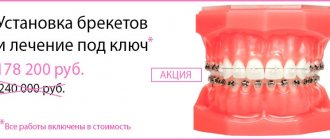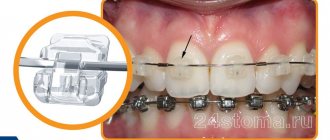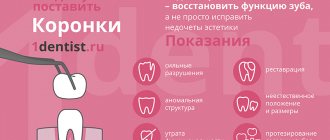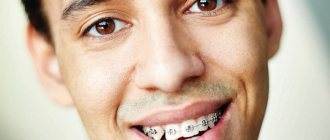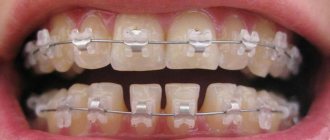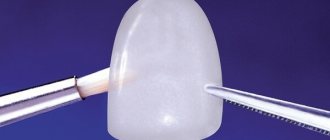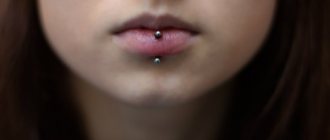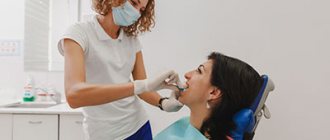Braces, or more precisely, braces systems, are structures that are used in dentistry to correct malocclusion and incorrect position of teeth. Braces are attached directly to the surface of the teeth and gradually lead to their displacement in a given direction. To date, this is the most effective method of orthodontic treatment. Unlike the same aligners, it is successfully used even in very complex cases.
- Indications for installing braces
- How do braces work?
- How is the treatment carried out?
- Types and composition of bracket systems
- Which braces are better?
- How long should you wear braces?
- Video of braces installation
- “Before and after” photos - correcting a bite using braces
- Doctors at the Novita clinic selecting and installing braces
- Prices for services for selection and installation of braces
- Sign up for a consultation
Indications for installing braces
Braces are used to correct abnormal bites and correct the position of teeth in the dentition. Braces can only be used on permanent teeth, so in children this treatment is used only from a certain age.
Why is it necessary to correct the position of teeth? Many people put aesthetics first - a beautiful smile and straight teeth make a person confident. However, dentists look at the problem from a different angle and put the functioning of the dental system first.
With a physiological occlusion, the teeth experience an even load during chewing, which ensures optimal functioning of the dental system. If there is a pathological arrangement of teeth, the load is distributed unevenly. Some teeth are overloaded, their enamel wears off more, and periodontal problems arise. All together this leads to tooth decay. In some cases it has to be removed. Prosthetics in this case can be problematic, due to the fact that it is not possible to achieve occlusion (closing) of the teeth.
On the other hand, teeth that do not receive the necessary load also suffer, no matter how paradoxical it may sound. Their blood supply deteriorates, which leads to the development of caries and periodontal problems.
Uneven loads also affect the temporomandibular joint. First, its dysfunction occurs, and then arthrosis. Ultimately, all this leads to the development of pain, the inability to open the mouth and make chewing movements.
Caring for ligature braces
As we have already indicated above, ligature braces require more careful care. All additional elements in the mouth prevent the free passage of the toothbrush during brushing. Ligatures are precisely these elements that interfere with hygiene. Rubber bands collect food debris and accumulate plaque. To thoroughly clean the lock, the ligature must be removed, but the patient does not have this option.
Therefore, hygiene must be maintained with available tools:
- Orthodontic brush with a special groove in the middle for braces
- A mono-beam brush that allows you to clean the lock around, the gingival area and the enamel under the arch.
- Orthodontic brushes are small brushes for hard-to-reach places - under the arch, in tooth spaces, around distant braces.
- An irrigator is a device that cleans surfaces and hard-to-reach places using a powerful jet of water. This is a hygiene instrument that is safe for mucous membranes and effective against food residues.
Complete care during treatment with braces is selected by an orthodontist or a hygienist. At the Confidence clinic you receive a detailed instruction manual on how to care for braces and can visit a hygienist at any time. He will point out mistakes in care and suggest the correct algorithm and home cleaning products.
How do braces work?
The bracket system consists of two components:
- An orthodontic arch that has shape memory.
- Fastening mechanisms that combine the arch and brackets into a single system. These mechanisms come in two types - ligature and non-ligature. We'll talk about them a little later.
The main element in the design is the orthodontic arch, which is given a specific shape (it is unique for each patient). The archwire is attached to braces that are pre-installed on each tooth. It will strive to take the given shape and will inevitably “pull its teeth along with it” in the right direction.
As the teeth shift, certain processes will occur in the bone tissue of the jaw. On the side where the tooth is displaced, bone resorption will occur (it will not dissolve), and vice versa, a new one will grow on the opposite side.
There are situations when the arch force is not enough and it cannot provide adequate displacement of the teeth. Then they resort to additional devices, for example, elastic chains or drop-down springs. They increase pressure on the teeth and provide correction of their position.
How is the treatment carried out?
Correcting the bite and straightening the teeth –
a complex and lengthy process that takes place in several stages:
- Diagnosis – a comprehensive dental examination is necessary. First, it is necessary to determine the correction method. Secondly, you need to make sure that there are no contraindications to orthodontic treatment. The patient's dentofacial system must withstand the load associated with tooth movement. For this purpose, all existing carious lesions are sanitized and, if necessary, treatment of paro- and periodontal tissues is carried out.
- The preparatory stage is the actual planning of orthodontic treatment. Based on the data obtained during the examination, calculations are made of models of the patient’s dental system, as well as calculations of an orthopantomogram and teleroentgenogram of the head in a lateral projection, and based on this, a treatment plan is drawn up.
- Installation of braces. First, the surface of the teeth is prepared. For this purpose, professional oral hygiene is performed, the enamel is dried, etched, washed and dried again. Only after this, adhesive (glue) compounds are applied and braces are installed. To make the glue work, it is polymerized using a lamp. The process of installing braces is presented in the video.
- Installation of an orthodontic arch. The duration and complexity of this process will depend on the method of attaching the braces. Ligature systems require more painstaking work than the use of non-ligature braces.
- Next, the patient must periodically visit the dentist to activate the arch. As the teeth move, the originally set arch shape will become irrelevant, so it must be periodically changed to a new one. The duration of wearing one arch is determined by the position of the teeth and the age of the patient. In young people, treatment is faster.
- Removal of braces and retention period. Once the teeth are in the desired position, the braces are removed. However, this is not the end of treatment. The fact is that the teeth will tend to take their original position, and to prevent this it is necessary to use supporting structures called retainers. In some cases, retainers will need to be used for life, in others - for several months or years after the braces are removed.
Does it hurt to get braces? Let's figure it out!
Does it hurt to put braces on children 13 years old? Is installing a system painful at 14 years old? Does it make a difference when to see a doctor? In fact, the installation algorithm does not depend on age, and always includes the following orthodontic manipulations:
- Cleaning the teeth with a special paste and covering the crown with a composition that increases enamel adhesion.
- Fixation of rings or locks on the distant chewing teeth, which are responsible for fastening the end parts of the arch.
- Gluing plates - correcting the position of the element and removing glue residues.
- Installation of a metal corrective arch into the grooves of the braces.
- Fastening the arch - with ligatures or using snap clasps.
The work is painstaking, requiring a thorough approach on the part of the dentist, but completely painless for the patient. The only discomfort at this stage is the need to keep your mouth open. The installation of a brace system on one jaw takes about an hour, so the orthodontist usually prescribes two appointments so as not to tire the patient and make it easier for him to adapt to the device.
Plaksina Margarita
“I install braces in two steps, with the interval between meetings reaching 3-6 months. This approach has great advantages: the child does not need to sit in a chair with his mouth open for 2-3 hours - that’s it. Accelerated adaptation to braces, reduction of discomfort during the adaptation period – two and three.”
Types and composition of bracket systems
Modern orthodontics has several types of braces in its arsenal. They may differ in design features, method of attaching the orthodontic arch and material of manufacture.
Depending on the method of fastening the arch, ligature and non-ligature systems are distinguished. Ligature systems are evolutionarily earlier. Here the arch is attached to the braces using ligatures, which have the form of rubber bands, wires, plastic rings, etc. This fastening reliably fixes the arch, which determines its complete immobility relative to the bracket. One of the advantages of this design is its relatively low cost. The disadvantages are the laboriousness of treatment - you need to frequently visit a doctor to activate the arc, and the process itself takes quite a lot of time. In addition, the ligature partially compensates for the force of the arc, which leads to an increase in the wearing time of the structure and difficulty in predicting the outcome of treatment.
In non-ligature systems, the arch is attached to the bracket using a special lock. This method of fastening facilitates the installation and activation of the arch and helps to ensure the displacement of teeth due to the action of weaker forces, i.e., the treatment occurs more physiologically. Non-ligating braces are also called self-ligating, and there are two ligation methods - active and passive. Active ligation involves a lock structure in which the arc is actively directed towards the groove. With passive ligation, the lock does not put pressure on the archwire and does not press it against the bracket. In other words, the arc can move relative to the groove to a certain extent. This makes the entire structure more physiological and makes it possible to better predict the result. Today it is considered the most progressive braces system.
Braces are also classified depending on where they are attached to the teeth. There are vestibular and lingual braces. Vestibular ones are attached to the front surface of dental crowns. Of course, they are noticeable to others, but at the same time they are easier to work with, they provide high predictability of treatment and are cheaper than lingual analogues.
Lingual braces are respectively attached to the lingual side of dental crowns. They are absolutely invisible to others, therefore they have high aesthetic characteristics. At the same time, there are a number of significant disadvantages - the volume of the oral cavity decreases, the design interferes with the tongue, rubs it, diction is impaired, and there are difficulties with chewing food. Such designs cannot be used for certain malocclusions and tooth alignment. In addition, such systems are expensive.
Braces are also classified according to the material they are made of:
- Metal braces are a classic of the genre. They are reliable and affordable.
- Plastic braces. The color is similar to tooth enamel, therefore they are more aesthetically pleasing than metal ones. But at the same time, they are more fragile and may not withstand the application of large forces, so the period of wearing the system increases. The advantages of plastic braces: they are more aesthetically pleasing, affordable, and quite convenient to use (less damaging to soft tissues). The disadvantages are fragility, duration of treatment, tendency to stain with food coloring.
- Ceramic braces. In terms of their aesthetic properties, they are as close as possible to tooth enamel, therefore they have high aesthetic characteristics. The material is more durable than plastic, but they are also more expensive.
- Sapphire braces are absolutely transparent and invisible on the teeth (as far as possible). Fragile, reliable, not painted with dyes, but expensive. Hard to remove
Which braces are better?
It is impossible to answer this question unambiguously. The choice of system is determined by the condition of the patient’s dentofacial system and his financial capabilities. The most powerful and reliable systems are vestibular metal ligature braces. This is a powerful tool for non-surgical treatment in orthodontics. With the help of such designs, the most complex problems are corrected. A significant advantage is the lowest cost. Their result and the effectiveness of such treatment can be assessed from the photo.
Ligature-free braces look more aesthetically pleasing and are softer, so they can be used for periodontal problems.
Aesthetic options for braces involve the use of materials that would be invisible against the background of tooth enamel. But the other part of the structure, the orthodontic arch, is still noticeable. Of course, there are options when it is coated with white Teflon, but this coating is unreliable and can partially peel off, then the arc will become striped. In terms of reliability, aesthetic braces are more fragile. They may break or come off.
What to choose? Decide for yourself based on the dentist’s recommendations, the characteristics of your clinical case and financial capabilities.
Advantages of ligature and non-ligature constructions
Each type of correction system has a whole list of undeniable advantages.
Pros of ligature braces:
- effective in correcting even the most complex defects;
- availability of treatment for patients of any age;
- affordability.
Advantages of self-ligating braces:
- aesthetic appearance, especially for ceramic structures;
- short adaptation period (about 2 weeks). Note: the duration of addiction depends on the individual characteristics of the patient;
- less frequent visits to the clinic to set up equipment (approximately once every 2 months);
- Possibility of use for periodontal disease;
- minimizing the risk of injury to the mucous membranes of the lips and cheeks;
- Easy to install and remove.
How long should you wear braces?
This question is also individual and depends on the existing problem and the age of the patient. The younger the person, the shorter the period of wearing the system. In children and adults, the average treatment period is 18 months.
It is also necessary to take into account that after removing braces, orthodontic treatment does not end. The position of the teeth still remains unstable due to the characteristics of the osseous-ligamentous apparatus of the jaw. If the teeth are not fixed, they will tend to return to their original position, which will lead to relapse. Therefore, additional fixation is required.
For this purpose, retainers and retention mouthguards are used on the upper and lower jaws. Mouthguards are worn for several hours a day, for example, while sleeping. Fixed retainers have the form of an arch, which is attached to the vestibular surface of the teeth using special adhesive materials. It is impossible to remove it yourself. The retention time is determined individually. In most cases, it is twice as long as you wear braces. However, for some patients, retention is indicated for life.
Dental health depends not only on timely diagnosis and treatment of carious lesions, but also on the overall development and well-being of the dental system, including periodontal condition, bite and other factors. Therefore, correcting the bite and straightening the teeth using vestibular braces is not limited to purely aesthetic purposes, but is also designed to preserve the health of your teeth and the entire oral cavity for as long as possible! And due to the close relationship of all body systems, healthy teeth and correct bite will be the key to normalizing the functioning of the gastrointestinal tract.
In our clinic we use brace systems from different manufacturers, but the best, in the opinion of our orthodontist, are the Experience series braces (GC Orthodontics, Japan) - the world leader among interactive non-ligature systems. Today, Experience is manufactured at the Japanese plant of TOMY Inc., which has been developing and manufacturing high-quality orthodontic systems since 1959 and is the owner of the Japan Quality Medal, the highest award for quality control in the world.
Correcting a bite with aligners
Compared to braces, aligners are clearly perceived as a super-modern, innovative technology for correcting bites, but this method was invented more than 50 years ago.
If you are interested in the history of the appearance of aligners, watch the video blog of the founder of the Russian company Star-Smile (one of the manufacturers of aligners).
Initially, treatment planning and aligner manufacturing technology were too labor-intensive, making the method expensive. At the same time, the aligners coped only with very simple defects.
A real breakthrough in the production of aligners occurred in 1997, when the American company Align Technology came up with a technology that made it possible to simulate a treatment plan for a specific patient on a computer and then automatically print a customized set of aligners to correct the bite. And all this on the scale of a large enterprise.
For more than 10 years, the company was the world's only supplier of aligners, and Invisalign orthodontic aligners still remain the most famous. The monopoly on production was protected by patents owned by the company, but as their validity expired, the technology for producing aligners spread throughout the world, including coming to Russia.
Active competition from manufacturers has made aligners more accessible and today they are cheaper than individual lingual braces, which we described above.
